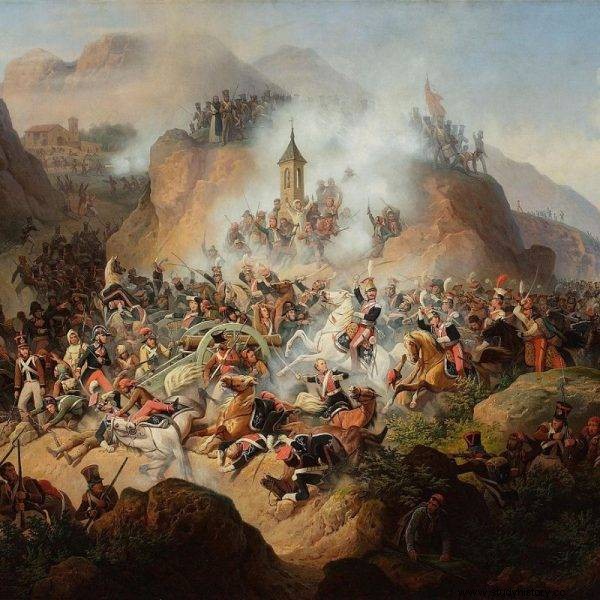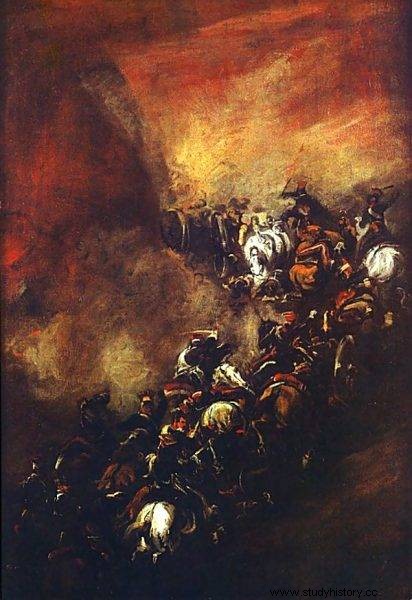Napoleon stood in front of a regiment of cavalrymen and, taking off his hat, exclaimed:"You are worthy of my old guard, I consider you the bravest cavalry." He had excellent reasons for this.
"Hello, the bravest of the brave." In this way, Napoleon was to pay tribute to the soldiers of the Polish Guard Cheval Legion Regiment the day after their charge at Somosierra (the common version of the name of the pass and valley - Samosierra - is Russian).
Battle place
On November 30, 1808, at dawn, the first troops of Napoleon's troops stood at the entrance to the Somosierra valley, through which was the shortest way to Madrid. The five-kilometer valley led to a pass, which was naturally formed, a perfect place for defense.

January Suchodolski, Szarża pod Somosierra (photo:public domain)
Contrary to popular belief, Somosierra was not (and is not) a gorge. However, just like in a ravine, you could only navigate a narrow road, no more than six meters at its widest points, for the relatively gently sloping slopes of the valley were covered with rock blocks. They obstructed the passage and at the same time gave great protection to the defenders.
Enemy positions
The passage was defended by the corps of General don Benit San Juan, who reached Somosierra on November 18. So the Spaniards had enough time to prepare for the defense. The general ordered a rampart to be erected on the pass and 10 out of 16 owned guns to be placed there. The remaining cannons were divided into three batteries, placed every few hundred meters along the road leading through the valley. Only the first of these batteries was reinforced with an earth embankment.
Along the road, behind the rock blocks, there were about a thousand soldiers. Nearly two thousand were deployed on the pass itself, while the rest of the over twelve thousand corps waited in a nearby village and on the southern slopes of the mountains. The Spaniards thought that this position was impossible to get, and in fact, it is hardly surprising.
Imprecise Order
At around 8.00 a.m. on November 30, the attack was launched by the French infantry. It was rejected by the guns of the first Spanish battery. Infuriated by the resistance, Napoleon ordered the 3rd squadron of Polish cavalrymen of the Guard to capture, as we may believe today, only this one battery. The order, however, was not worded precisely enough and could have been interpreted as an order to control the pass.

The Battle of Somosierra, a painting by Piotr Michałowski (photo:public domain)
The squadron commanded by Jan Leon Kozietulski (1781–1821) had 216 horsemen, most of whom were to fight for the first time. Losing a dozen or so people as a result of an artillery salvo by the Spaniards, the Polish unit obtained the first battery. Unsure of the scope of the emperor's order, Kozietulski attacked another. Its capture was facilitated by the lack of an earthen embankment, but the squadron was constantly under fire from soldiers on both sides of the road.
I consider you to be the bravest ride
Losing more people, wounded or killed, including almost all officers, including Kozietulski, the Poles captured all four batteries. Only a dozen or so soldiers reached the last one and its maintenance was possible only thanks to the support of the 1st squadron under the command of Tomasz Łubieński. The road to Madrid was open.

Polish cavalrymen under Somosierra, Jerzy Kossak.
The day after the battle, during the review of the Polish regiment, Napoleon stood in front of the cavalry regiment and, taking off his hat, exclaimed:“You are worthy of my old guard, I consider you the bravest cavalry. Praise the bravest of the brave! ”
Source:
The above text originally appeared as one of the entries of Lexicon of Polish historical sayings . The book by Maciej Wilamowski, Konrad Wnęk and Lidia A. Zyblikiewicz was published by Znak Publishing House in 1998.
The title, lead, illustrations with captions, boldface text, paragraph division and subheadings come from the editors. The text has undergone basic editing.
